|
Dual 4-channel multiplexer plan B: behavioural single-file VHDL (flat) |
Type 74HCT153 chip
| 1. Specifications | Planning | Developing | Functional test | Gate-level test | Prototype | Report |
Design a classic chip like the 74HCT153 using behavioral approach plan B.
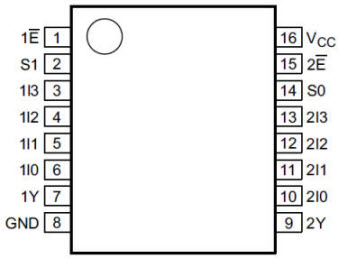 a) a) |
Fig. 1. a) Case and pin naming and enumeration of a classic 74HCT153 chip. We will interpret it as shown in b). Vector data select S(1..0) may be represented in binary radix-2 or as an unsigned decimal. Symbol name is Dual_MUX_4 meaning that data input channels and output are dual, they have two-bit size Ch0 --> Ch0(1..0). In other applications we may have other expanded devices like Octuple_MUX_8, meaning that Channel size is 8-bit for instance Ch0(7..0), and select channel is S(2..0) to be able to switch 8 data channels . Enable is active-low (E_L) meaning that the chip operates when E_L = '0'. |
b)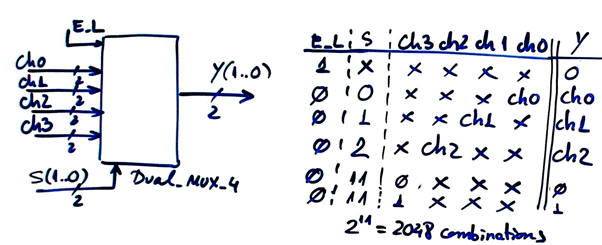  - How many maxterns does Y(1) have? - How many minterns does Y(0) have? |
|
Draw the sketch of a timing diagram to demonstrate how the circuit works for several input stimulus.
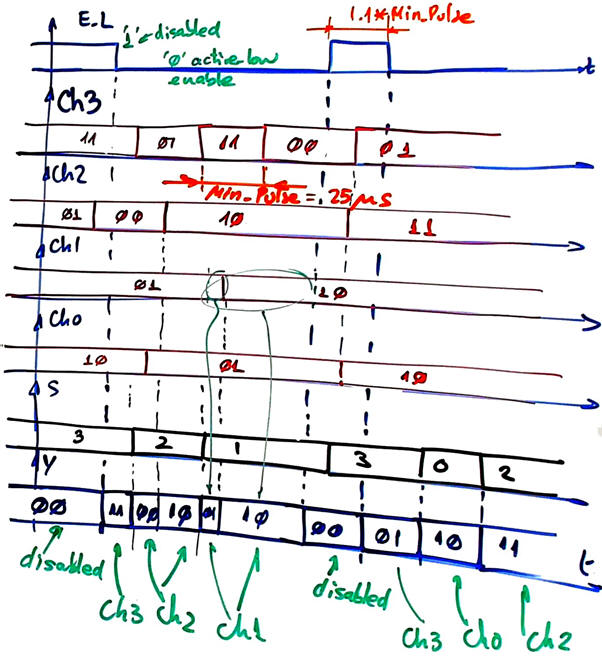 |
| Fig. 2. Example timing diagram. |
| Specifications | 2. Planning | Developing | Functional test | Gate-level test | Prototype | Report |
The idea now is the interpretation of the circuit's truth table as a flow chart, generating several possibilities.
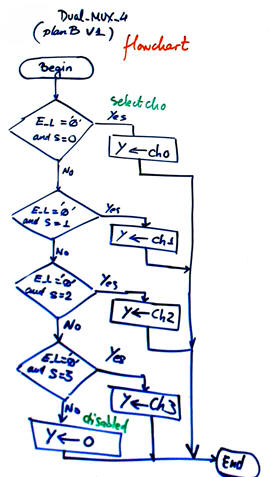 a) a) |
 c) c) |
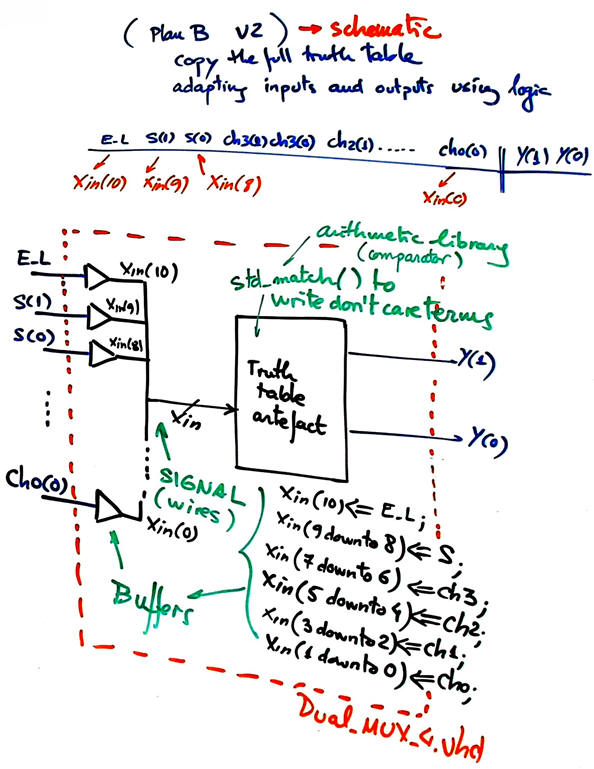 b) b) |
|
| Fig. 3. Plan B schematics and flowcharts. Several ways of interpreting the same truth table. | |
Project and file locations (three plans have to be placed in three folders):
C:/CSD/P2/Dual_MUX_4_B1/(files)
C:/CSD/P2/Dual_MUX_4_B2/(files)
C:/CSD/P2/Dual_MUX_4_B3/(files)
| Specifications | Planning | 3. Developing | Functional test | Gate-level test | Prototype | Report |
Three VHDL translations of Fig. 3: plan B a) Dual_MUX_4.vhd; plan B b) Dual_MUX_4.vhd; plan B c) Dual_MUX_4.vhd
This is the entity description to CSD input and output naming.
 |
| Fig. 4. Entity definition that is the same whatever the plan. |
Start an EDA synthesis project and examine results.
Several schematics are possible, depending on the flowcharts or truth table translations.
 |
|
Fig. 5a. RTL schematic of Dual_MUX_4 using Fig. 3a. This is the way in which the EDA synthesiser has translated the flowchart into an electronic circuit. Comparators, multiplexers and logic gates are used. |
| Fig. 5b. RTL schematic of Dual_MUX_4 using Fig. 3b. |
| Fig. 5c. RTL schematic of Dual_MUX_4 using Fig. 3c. |
In the end, the same final circuit (technology view) will be placed and routed into the PLD accordingly to its technology (sPLD, CPLD or FPGA) and manufacturer (Lattice, Intel, Xilinx, etc.).
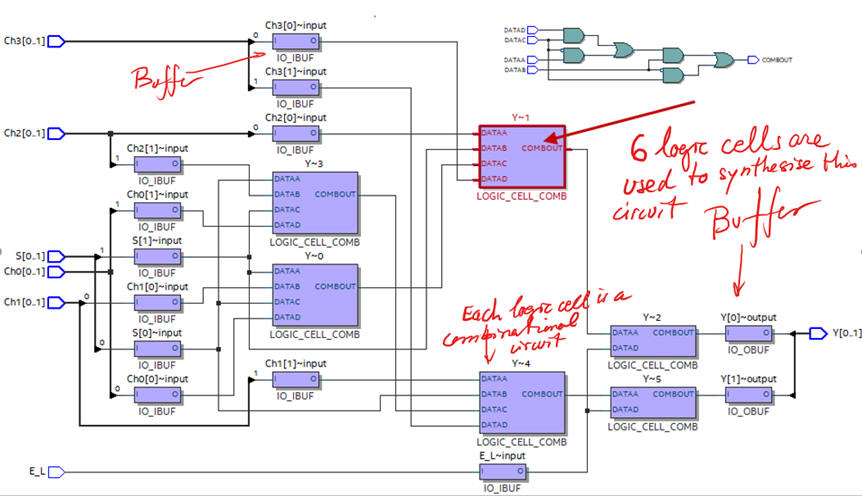 |
| Fig. 6. Technology view. |
| Specifications | Planning | Developing | 4. Functional test | Gate-level test | Prototype | Report |
In Fig. 7 is represented the testbench schematic to stimulate the unit under test (UUT) with input vectors. Generate the skeleton of the testbench file and add stimulus translating to VHDL input activity from the time diagram in Fig. 2. This is an example of a simple test bench Dual_MUX_4_tb.vhd where the inputs have been stimulated with logic values.
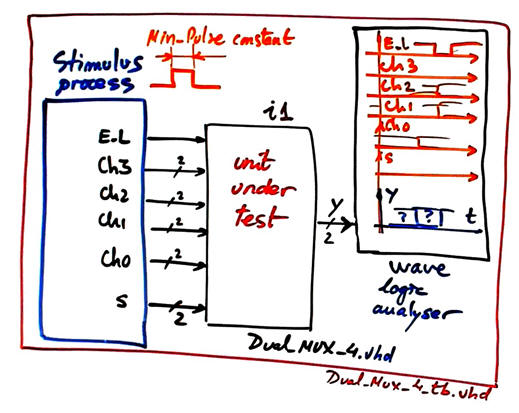 |
Fig. 7. Testbench fixture to verify that our circuit works as expected. |
Start the VHDL simulator project, Dual_MUX_4_functional_sim, and run the test. Verify applying sufficient test vector that the device works as expected (verify how the information of each channel is selected). Print timing diagram screen and add comments on the signals to show how the device works.
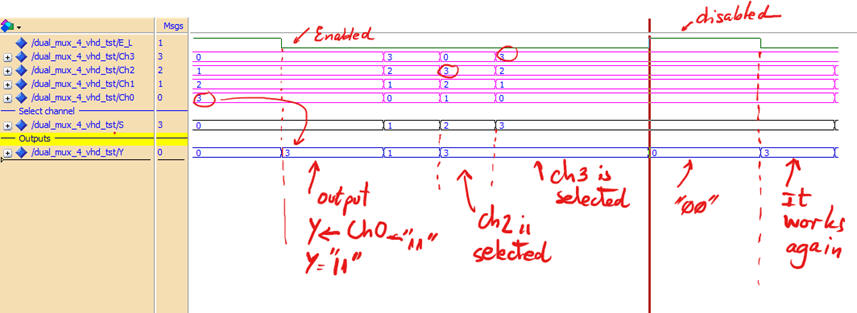 |
| Fig. 8. Waveform results from the logic analyser. |
| Specifications | Planning | Developing | Functional test | 5. Gate-level test | Prototype | Report |
| Specifications | Planning | Developing | Functional test | Gate-level test | 6. Prototype | Report |
| Specifications | Planning | Developing | Functional test | Gate-level test | Prototype | 7. Report |
Follow this rubric for writing reports.


